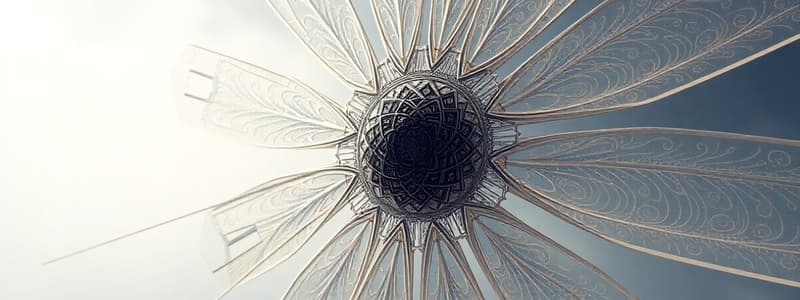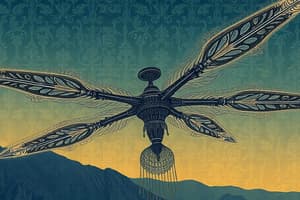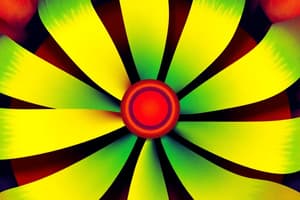Podcast
Questions and Answers
Which rotor blade design provides a better aerodynamic pitch characteristic?
Which rotor blade design provides a better aerodynamic pitch characteristic?
- Uniform
- Symmetrical (correct)
- Asymmetrical
- Tapered
Which rotor blade design generates greater lift for the same surface area?
Which rotor blade design generates greater lift for the same surface area?
- Parallel
- Tapered
- Asymmetrical (correct)
- Symmetrical
How do engineers stabilize the aerodynamic characteristics of an asymmetrical rotor blade?
How do engineers stabilize the aerodynamic characteristics of an asymmetrical rotor blade?
- By reducing the camber
- By sweeping the edges 3 degrees upwards (correct)
- By increasing the thickness of the blade section
- By using a uniform planform
What is the most common type of rotor blade design?
What is the most common type of rotor blade design?
Which rotor blade planform has a leading and trailing edge that run parallel to each other?
Which rotor blade planform has a leading and trailing edge that run parallel to each other?
Why do manufacturers prefer to produce uniform blade planforms?
Why do manufacturers prefer to produce uniform blade planforms?
What is a characteristic of a single-pocket skin configuration?
What is a characteristic of a single-pocket skin configuration?
Where are trim balance weights added to a rotor blade?
Where are trim balance weights added to a rotor blade?
What is the primary purpose of the flat black paint on the bottom of rotor blades?
What is the primary purpose of the flat black paint on the bottom of rotor blades?
Which type of rotor blades are required to have static discharge abilities?
Which type of rotor blades are required to have static discharge abilities?
Where are spanwise balance weights typically located on a rotor blade?
Where are spanwise balance weights typically located on a rotor blade?
Which action will cause a rotor blade to fly higher in its plane of rotation?
Which action will cause a rotor blade to fly higher in its plane of rotation?
What is the purpose of stainless steel capping on the leading edges of rotor blades?
What is the purpose of stainless steel capping on the leading edges of rotor blades?
Which rigging component needs to be set up first when working on a helicopter?
Which rigging component needs to be set up first when working on a helicopter?
What is the effect of bending the trim tab lower on a rotor blade?
What is the effect of bending the trim tab lower on a rotor blade?
What is the purpose of the correlator in a helicopter's control system?
What is the purpose of the correlator in a helicopter's control system?
What should be confirmed before connecting the collective and throttle?
What should be confirmed before connecting the collective and throttle?
What is the final flight test completed on a helicopter after rigging?
What is the final flight test completed on a helicopter after rigging?
Where is a servo tab typically located on a rotor blade?
Where is a servo tab typically located on a rotor blade?
What primary function does the main servo flap serve?
What primary function does the main servo flap serve?
In what order should flight controls be rigged?
In what order should flight controls be rigged?
Which system is more complex on a helicopter, a droop compensator or correlator?
Which system is more complex on a helicopter, a droop compensator or correlator?
What type of airfoil is a fixed elevator on a helicopter?
What type of airfoil is a fixed elevator on a helicopter?
Flashcards
Symmetrical Blade Design
Symmetrical Blade Design
A blade design with equal lift distribution on both sides.
Asymmetrical Blade Design
Asymmetrical Blade Design
A blade design with unequal lift distribution on both sides, resulting in higher lift on the side with greater camber.
Uniform Planform
Uniform Planform
A blade design with a uniform chord length from root to tip.
Tapered Planform
Tapered Planform
Signup and view all the flashcards
Single Pocket Skin Configuration
Single Pocket Skin Configuration
Signup and view all the flashcards
Multi-pocket Skin Configuration
Multi-pocket Skin Configuration
Signup and view all the flashcards
Trim Balance Weight
Trim Balance Weight
Signup and view all the flashcards
Bonded Construction
Bonded Construction
Signup and view all the flashcards
Weight Aft of Trim Tabs
Weight Aft of Trim Tabs
Signup and view all the flashcards
Stainless Steel Capping on Rotor Blades
Stainless Steel Capping on Rotor Blades
Signup and view all the flashcards
Black Underside of Rotor Blades
Black Underside of Rotor Blades
Signup and view all the flashcards
Static Discharge in Composite Blades
Static Discharge in Composite Blades
Signup and view all the flashcards
Rotor Blade Materials
Rotor Blade Materials
Signup and view all the flashcards
Tap Testing Composite Blades
Tap Testing Composite Blades
Signup and view all the flashcards
Multi-Pocket Blade Skin
Multi-Pocket Blade Skin
Signup and view all the flashcards
Double Plates at Blade Root & Tip
Double Plates at Blade Root & Tip
Signup and view all the flashcards
Servo Flap
Servo Flap
Signup and view all the flashcards
Rigging Flight Controls
Rigging Flight Controls
Signup and view all the flashcards
Droop Compensator
Droop Compensator
Signup and view all the flashcards
Correlator
Correlator
Signup and view all the flashcards
Bifilar Vibration Absorber
Bifilar Vibration Absorber
Signup and view all the flashcards
Hub Vibration Absorber
Hub Vibration Absorber
Signup and view all the flashcards
Force Trim System
Force Trim System
Signup and view all the flashcards
Elevator
Elevator
Signup and view all the flashcards
Study Notes
Rotor Blade Designs
- Two main designs: symmetrical and asymmetrical
- Symmetrical blades have better aerodynamic pitch characteristics
- Asymmetrical blades produce more lift for the same surface area
- Asymmetrical blades have greater camber on one side
Blade Design Characteristics
- Asymmetrical blades are achieved by sweeping the edges 3 degrees upwards, aiding aerodynamic stability
- Symmetrical blades are most common due to asymmetrical blades' unstable aerodynamic characteristics
- Two main planform types: parallel (uniform) and tapered
- Uniform planform: leading and trailing edges run parallel to each other
- Tapered planform: leading and trailing edges converge, chord length reduces towards the blade root
Planform Preferences
- Manufacturers prefer uniform planforms due to cost-effectiveness (single machine stamping).
- Uneven chord length of tapered planforms necessitates changing rib numbers per rib for each blade.
- Tapered planforms improve lift equality across the blade, compensating for speed variations
Blade Twist
- Parallel blades have a negative twist to achieve higher angles of attack at the root, maintaining equal lift from root to tip despite differing rotational speeds.
Skin Configurations
- Single pocket is faster to build.
- Multiple pockets make repairs more manageable and reduce damage from one damaged sheet.
- Single pocket skin configuration is less easily repaired when damaged.
- Single pocket skin needs complete replacement if damaged.
Construction Methods
- Bonded construction is preferred because of strength and lack of drilling holes for fasteners.
Rotor Blade Weights
- Trim balance weights are not movable while the helicopter is in flight; they can be repositioned during repairs
- Weights added to the leading edge of the rotor blade lower the helicopter in flight
- Weights added to the trailing edge raise the helicopter in flight
Trim Tabs
- Trim tabs improve aerodynamic efficiency for better pitch control.
- Trim Tabs affect rotor blade flight path
- Trim tabs adjustments are easily made to control rotor blade flight path
Additional Considerations
- Static discharge capabilities are required for composite blades
- Common rotor blade materials include composites, metal, and wood
- Tap testing is a common inspection method for composite rotor blades
- Multiple pockets are more expensive to build
Studying That Suits You
Use AI to generate personalized quizzes and flashcards to suit your learning preferences.




